Looking for a delicious vegan mooncake recipe? The Mid-Autumn Festival is a cherished occasion in many East Asian countries, particularly China, where families gather to celebrate under the full moon. Central to this celebration are mooncakes, traditional pastries filled with sweet ingredients like lotus seed paste or red bean paste.
However, for those following a plant-based diet or preferring cruelty-free alternatives, creating vegan mooncakes allows for participation in this cultural tradition without compromise. This vegan mooncake recipe offers a delightful twist on the classic treat, incorporating plant-based ingredients and flavors to celebrate the festival in harmony with personal values.
The Difference Between Traditional Chinese Mooncakes and Vegan Mooncakes
Traditional Chinese Mooncakes

Traditional Chinese mooncakes and vegan mooncakes share many similarities. But there are some key differences that set them apart, particularly in terms of ingredients and preparation methods. Traditional mooncakes, often enjoyed during the Mid-Autumn Festival or lunar new year, typically include ingredients like wheat flour, lard, and egg yolks. Making them rich and flavorful but not suitable for those following a vegan diet.
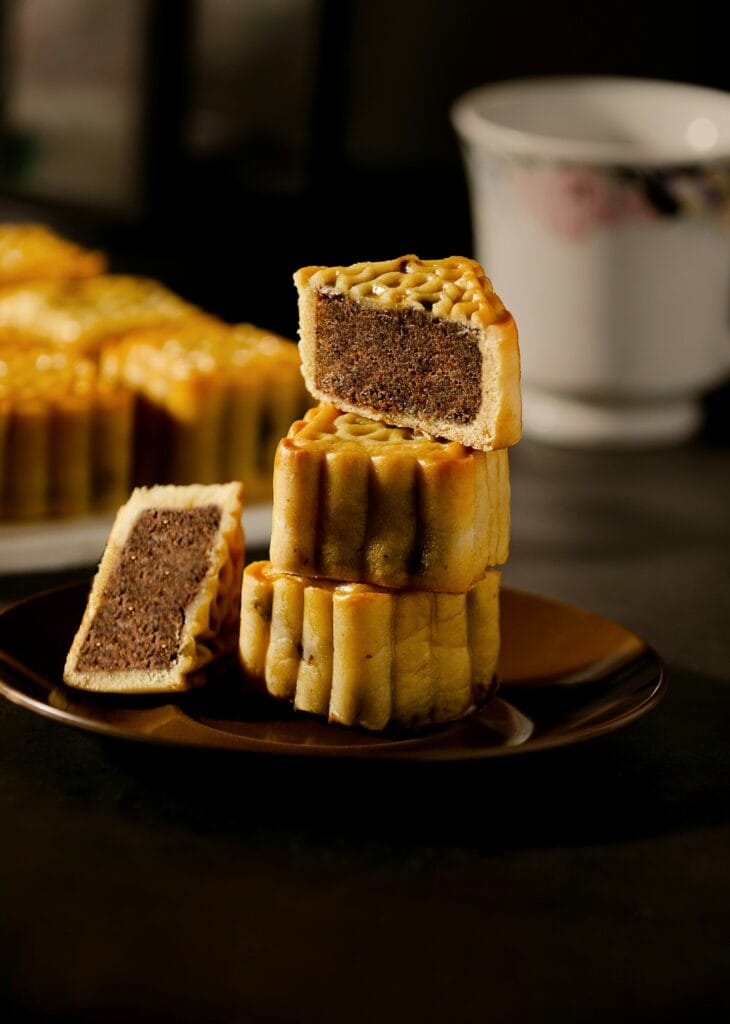
Normal mooncakes often feature fillings such as lotus paste, red bean paste, and even savory options like salted egg yolk and meats. Traditional baked mooncakes are usually made with a combination of wheat flour and lard, giving them a tender, flaky crust that encases the sweet or savory filling.
Plant Based Mooncakes
In contrast, vegan mooncakes, like the ones detailed in this recipe, use plant-based ingredients to achieve a similar taste and texture. For example, vegetable oil or coconut oil is used instead of lard, and alkaline water helps maintain the dough’s unique texture and color.
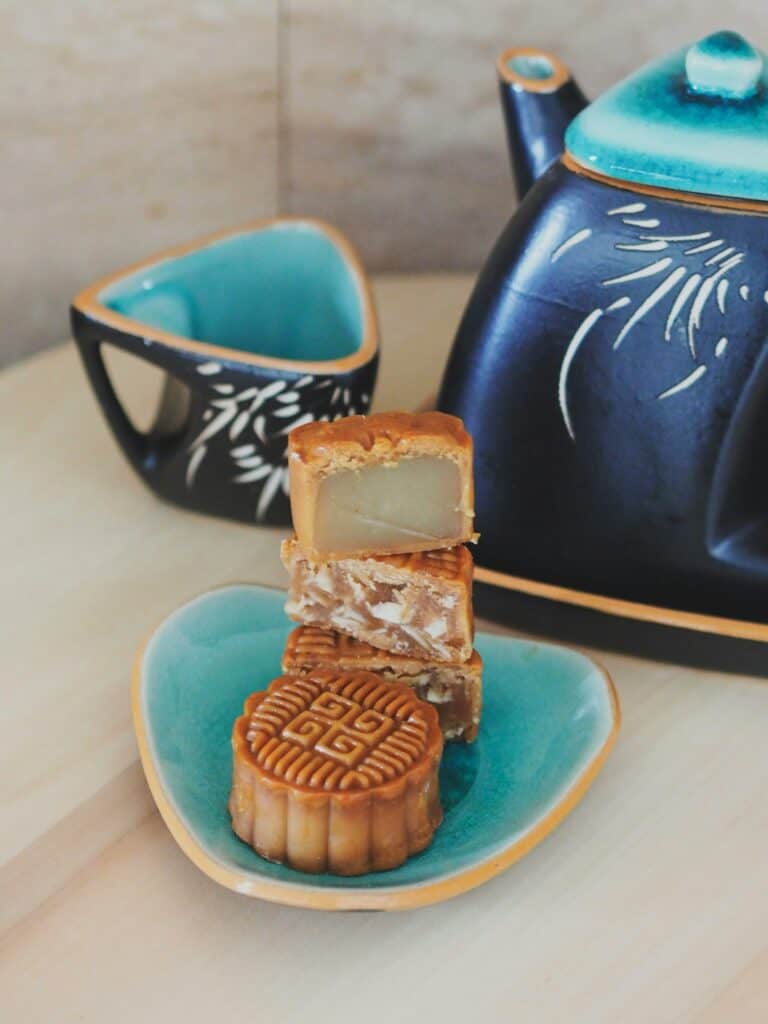
The fillings for vegan mooncakes are also plant-based, with options like lotus paste or red bean paste remaining popular. Additionally, vegan versions can include creative alternatives such as dark chocolate truffle centers or a vegan egg yolk substitute made from ingredients like potato starch. These vegan adaptations make homemade mooncakes accessible to those adhering to plant-based diets while retaining the Chinese tradition.
Preparation of Vegan Mooncakes
The preparation of vegan mooncakes also involves modern techniques and tools to streamline the process. Using mooncake molds ensures consistent shape and design, a crucial aspect of these festive treats.
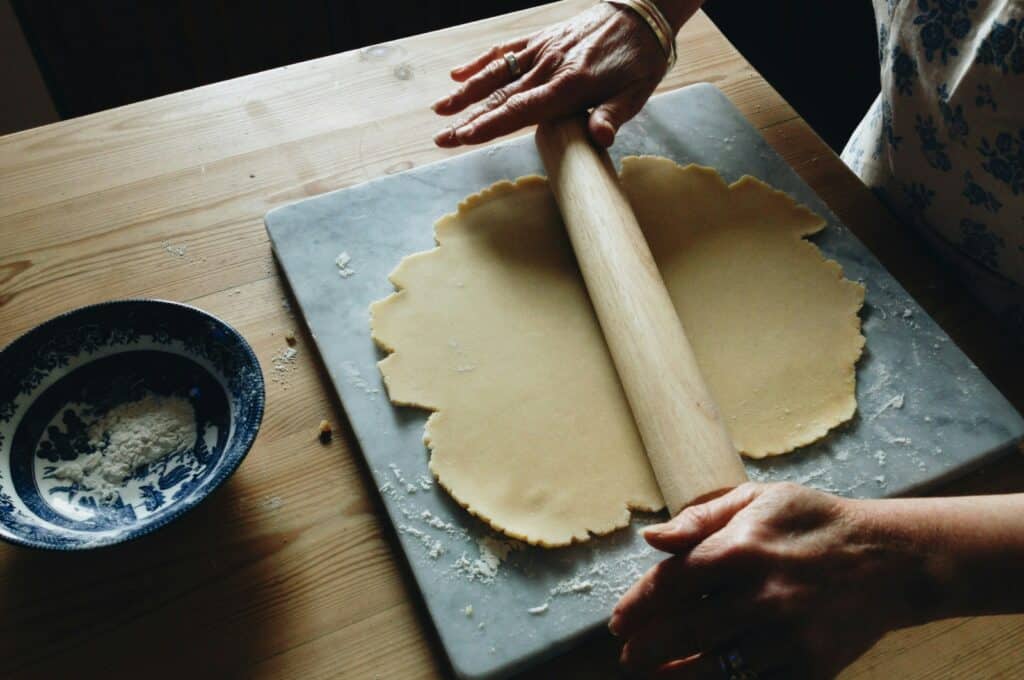
In this vegan recipe, the dough and filling are prepared separately, then combined by rolling the filling into small balls and wrapping them with the dough. The mooncakes are then pressed into molds, which give them their iconic, intricate patterns. Baking the mooncakes at medium low heat in a thick-bottomed pan or a non-stick pan ensures even cooking without burning.
Snow Skin Mooncake
Another popular variant within the food space is the snow skin mooncake, which is a no-bake option made with glutinous rice flour. These mooncakes are served chilled and have a chewy texture, providing a refreshing alternative to the traditional baked versions. The vegan version of snow skin mooncakes uses similar plant-based substitutions and is often enjoyed with jasmine tea during celebrations.
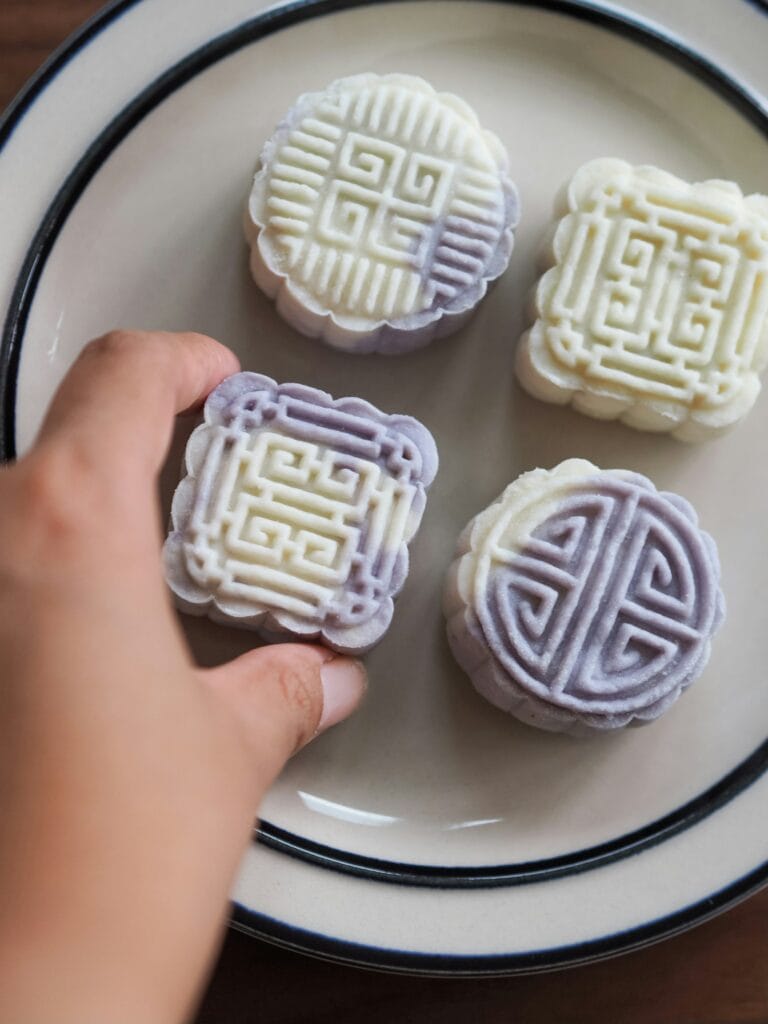
Vegan mooncakes are a wonderful addition to the array of traditional Chinese pastries, offering a healthier and more inclusive option without compromising on flavor. They cater to the growing demand for plant-based foods in the United States and beyond. These mooncakes can be enjoyed during the harvest moon festival, Chinese New Year, or any other festive occasion. Pairing them with a cup of soy milk or jasmine tea completes the experience, making it a delightful and culturally rich treat for everyone.
Different Between Chinese Mooncakes and Korean Songpyeon
Chinese Mooncakes
Both Chinese mooncakes and Korean songpyeon are traditional festive treats enjoyed during their respective cultural celebrations. They differ significantly in ingredients, preparation, and symbolism. Chinese mooncakes, often enjoyed during the Mid-Autumn Festival, include variations like egg yolk mooncakes, which feature a rich filling often containing salted egg yolks.
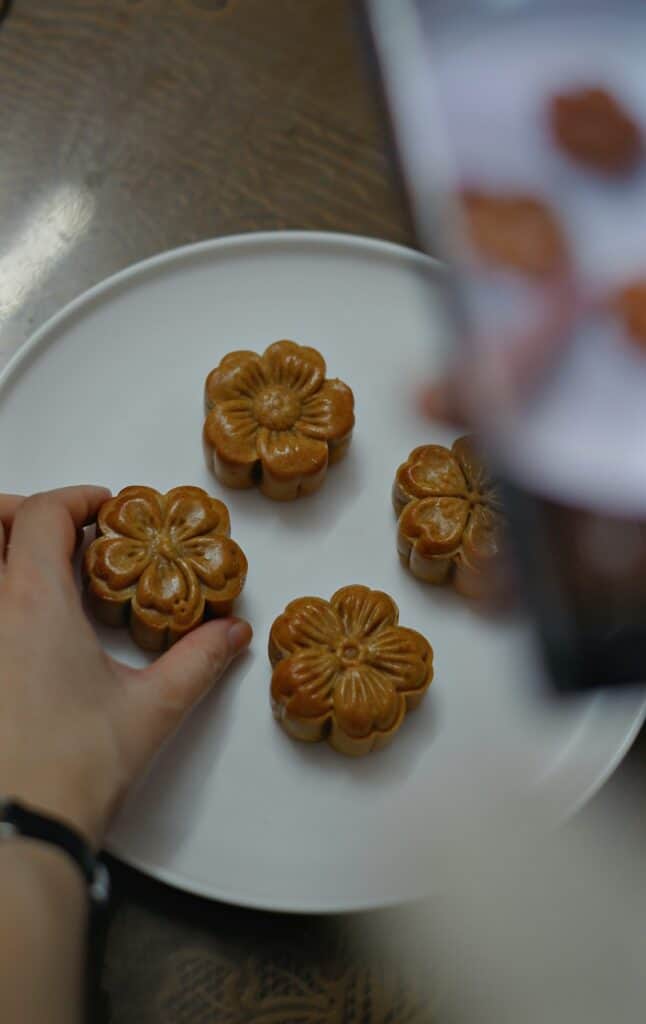
These mooncakes are baked at high heat until golden brown, sometimes with intricate designs, and are typically made using a combination of wheat flour, sweet fillings, and sometimes lard or vegetable oil.
Korean Songpyeon
In contrast, South Korea’s songpyeon, a highlight of the Chuseok festival, are half-moon shaped glutinous rice balls filled with ingredients such as sesame seeds, chestnut paste, or sweetened red beans. Unlike the baked mooncakes, songpyeon are steamed rather than baked, often over a bed of pine needles which impart a unique aroma.
The dough for songpyeon is made from rice flour, which gives it a chewy texture, and the steaming process involves using a heat-proof container placed inside a sauce pan or steamer. While mooncakes can be quite rich and dense, songpyeon are known for their delicate texture and subtle sweetness.
Both treats reflect their cultural origins, with mooncakes sometimes accompanied by other Chinese pastries like almond cookies, while songpyeon is enjoyed alongside various traditional Korean dishes. Despite their differences, both are essential to their respective festivals, symbolizing harvest and family reunion.
Ingredients & Substitutions
Mooncake Dough
Crafting the perfect mooncake dough requires a delicate balance of ingredients:
- Cake Flour: Provides the base for the dough, ensuring a tender texture. If you prefer a slightly firmer dough, you can mix in some all purpose flour.
- Alkaline Water: Adds a unique flavor and distinctive color to the dough, a hallmark of traditional mooncakes.
- Vegetable Oil or Coconut Oil: Substituting traditional animal fats, these oils keep the dough moist and pliable. For a richer taste, you can use full-fat coconut milk instead of water.
- Golden Syrup or Maple Syrup: Offers sweetness and acts as a binding agent in the dough. Using maple syrup gives a slightly different flavor profile but works well in vegan versions of mooncakes.
One of the most important dry ingredients is a little extra flour for dusting. Dusting each pastry ball before placing it into the mould will help prevent sticking. A little bit goes a long way in this recipe.
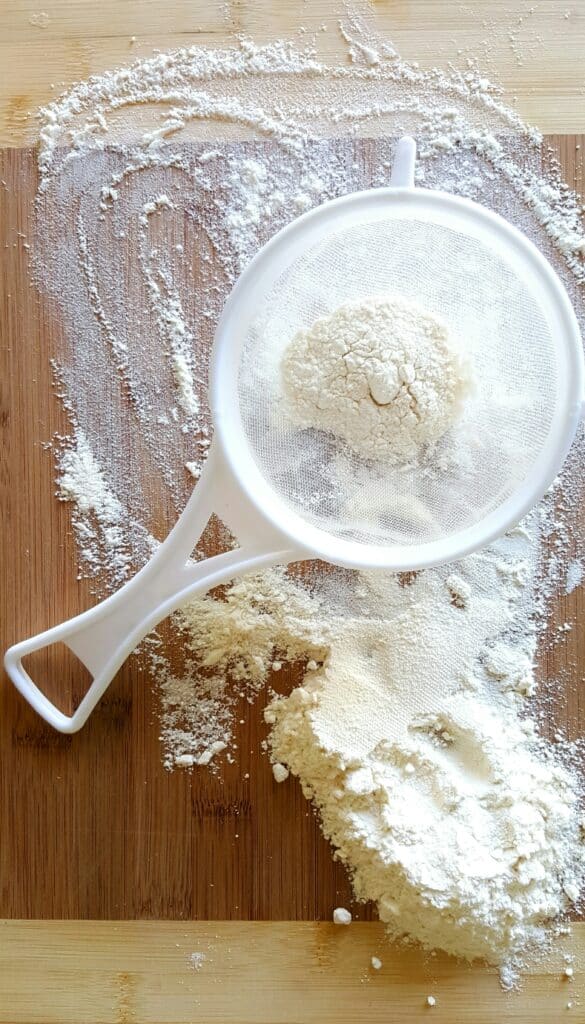
For those interested in experimenting with different styles of mooncakes, snow skin mooncakes provide a popular alternative. These are made with cooked glutinous rice flour and do not require baking, giving them a chewy texture.
Mooncake Filling
The heart of any mooncake lies in its filling which is placed in the center of the pastry:
- Lotus Paste or Red Bean Paste: Traditional fillings that evoke nostalgia and sweetness. Sweet red bean paste, made from adzuki beans, is a classic choice for red bean mooncakes.
- Chocolate Truffles or White Chocolate Chips: Adds a modern twist to the traditional recipe, appealing to diverse tastes. For an indulgent touch, try using dark chocolate truffle centers.
- Custard Filling: For those who enjoy a creamy texture, vegan butter can be used to create a luscious custard filling.
- Lavender Lotus Paste: For a unique flavor, this filling combines floral notes with the traditional sweetness of lotus paste.
- Date Paste Ball: Another traditional option, date paste offers a rich and natural sweetness.
To form the filling balls, simply roll small pieces of the filling into round shapes. This step ensures the filling stays centered in the pastry part of the mooncake.
Syrup Glaze / Topping
For that final touch of perfection mix these together in a small bowl:
- Golden Syrup: Creates a glossy finish and enhances the sweetness of the mooncakes.
- Water: Dilutes the syrup for easy application. Use enough water to get the right consistency for brushing.
- Salt: Balances the sweetness with a hint of saltiness, elevating the flavor profile.
Adding a touch of pandan leaves to the glaze can impart a subtle, fragrant aroma. For an elegant presentation, sprinkle some black sesame seeds on top.
Helpful Tools To Make This Vegan Mooncake Recipe
Mooncake Moulds
Investing in quality mooncake moulds ensures consistent shapes and professional-looking results.
Plastic Wrap
Using plastic wrap when working with the dough prevents sticking and simplifies the assembly process.
Food Processor
For those opting for homemade fillings, a food processor makes quick work of processing cooked beans or creating smooth pastes.
Baking Sheet and Airtight Container
A baking sheet is essential for baking the mooncakes to perfection, while an airtight container keeps them fresh for extended enjoyment.
How to Make This Vegan Mooncake Recipe
Preparing the Dough
- In a large bowl, combine the cake flour, alkaline water, vegetable oil, and golden syrup.
- Knead the mixture until it forms a smooth dough, then cover with plastic wrap or a damp cloth and let it rest at room temperature for optimal texture.
Creating the Filling
- Next, prepare your fillings. Traditional sweet red bean paste or lotus paste can be used, or you can try more modern fillings like dark chocolate truffles or lavender lotus paste. Form the fillings into small filling balls and set aside.
- Roll the paste into 30 g portions for convenient assembly later.
Assembling and Baking The Vegan Mooncakes
Divide the dough into 9 equal pieces. (Each should be about 20g.) Then divide each of those in half.

Roll them flat, then place the filling ball in between 2 pastry rounds.
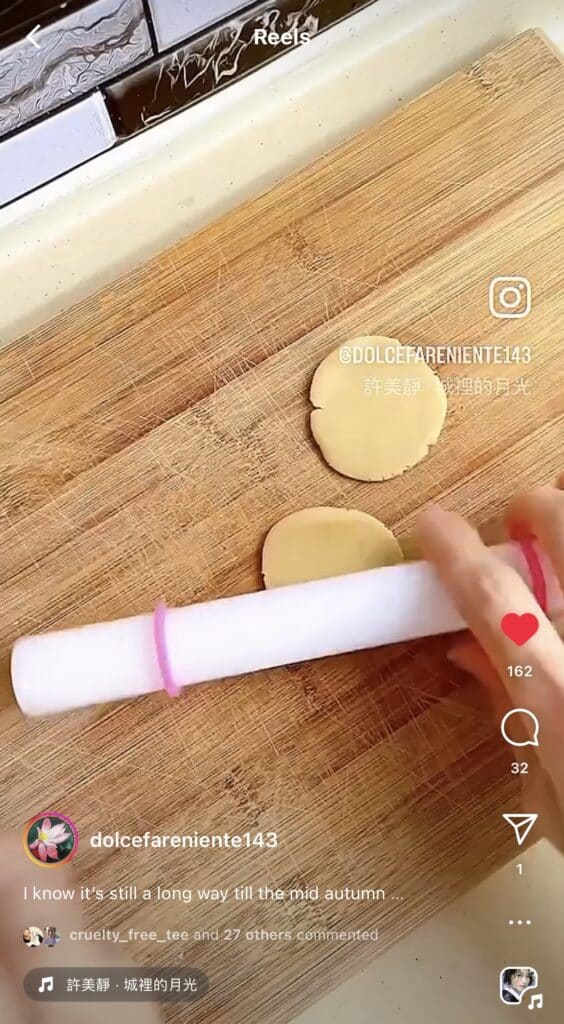
Gently seal the closed using your fingers, then roll into a smooth ball.
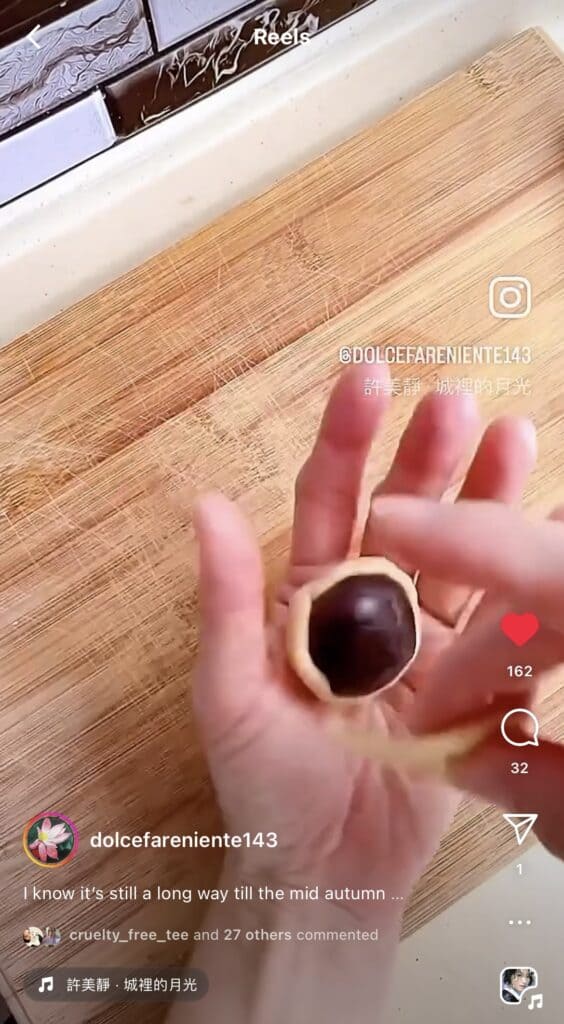
The filling balls should be completely covered by the pastry.

Dust each mooncake with a little flour to prevent sticking.
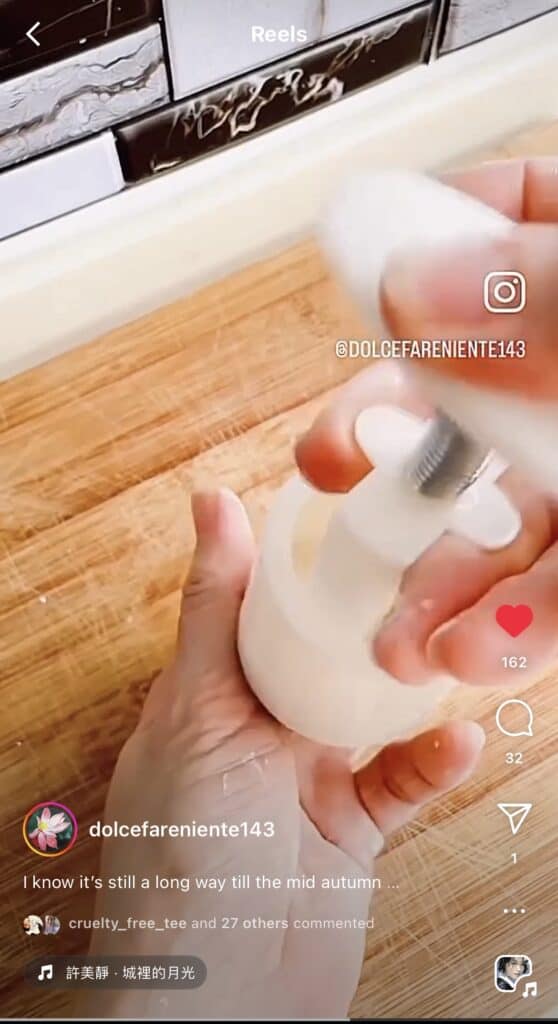
These round cakes are then pressed into a mooncake mould to impart the desired design.
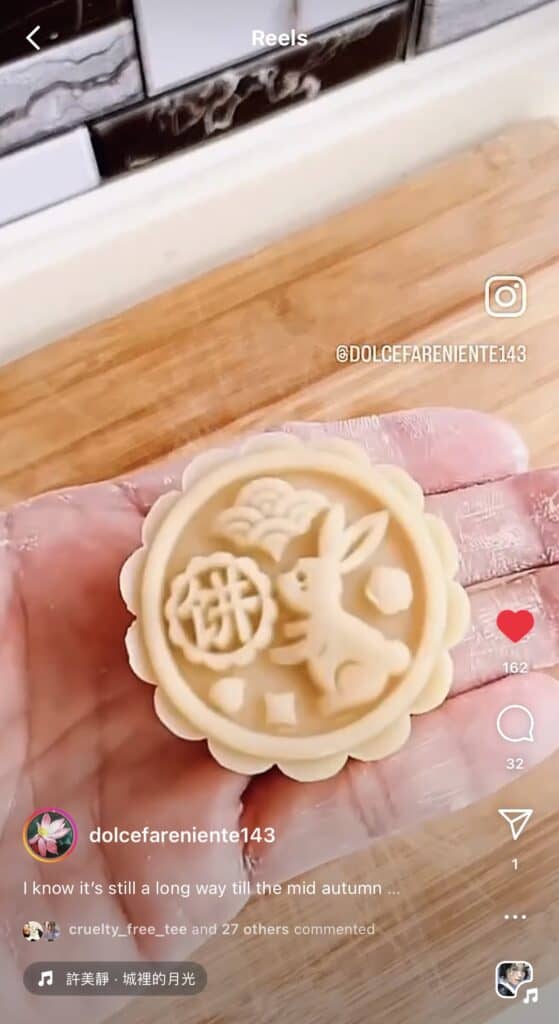
Brush the mooncakes with a mixture of golden syrup, water, and salt for a glossy finish.

- Place the molded mooncakes onto a baking sheet lined with parchment paper and bake at medium heat until golden brown.
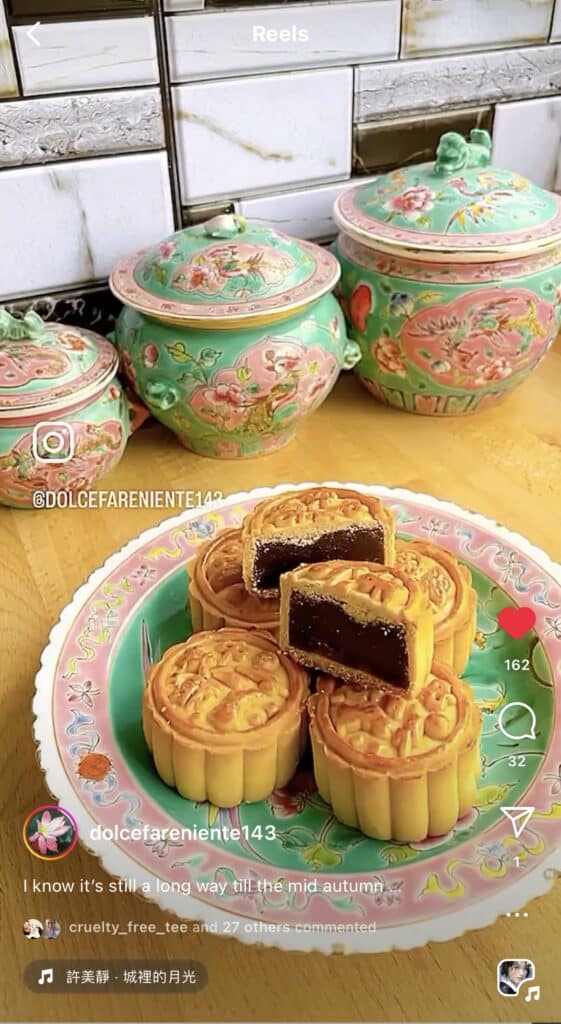
Tips & Tricks
Expert Advice For This Vegan Mooncake Recipe
- When working with the dough, keep it at medium-low heat to prevent it from becoming too sticky.
- Experiment with different fillings and shapes to create unique styles of mooncakes.
- Store leftover mooncakes in an airtight container to maintain freshness for longer periods, perfect for enjoying on special occasions.
These delicious vegan mooncakes are made by Dolce Fare Niente. (Her instagram is @dolcefareniente143) For those new to mooncake making, a bonus video tutorial by vegan bakery Annie’s T Cakes, run by Annie Wang, can be a helpful guide.
FAQs (Frequently Asked Questions)
- What is the significance of mooncakes in Chinese culture? Mooncakes symbolize unity and togetherness, making them a staple during festivals like the Mid-Autumn Festival.
- Can I use coconut oil instead of vegetable oil in the dough? Yes, coconut oil can be substituted for vegetable oil to achieve a similar texture and flavor profile in the dough.
- Where can I find mooncake moulds for making vegan mooncakes? Mooncake moulds are readily available at specialty kitchen stores or online retailers catering to vegan baking needs.
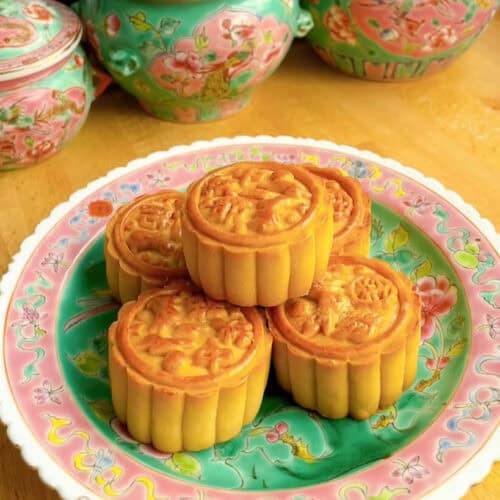
Vegan Mooncakes Recipe
Ingredients
Mooncake Dough
- 100g cake flour
- 4g alkaline water
- 25g vegetable oil
- 60g golden syrup
Mooncake Filling
- 270g lotus paste or red bean paste
Syrup Glaze / Topping
- 1 tsp golden syrup
- 1 tsp water
- small pinch of salt
Instructions
Making the Dough
- In a large mixing bowl, add cake flour, alkaline water, vegetable oil and golden syrup.
- Stir to thoroughly combine all ingredients for the dough, then cover and let rest for 1-3 hours. Gently knead the dough if required.
Making the Glaze
- In a medium mixing bowl, combine golden syrup, water and a small pinch of salt. Stir to combine and set aside.
Assembling the Mooncakes
- Take your filling of choice (lotus paste or red bean paste) and divide into 30g portions. Roll each portion into a ball.
- Next, divide the dough into 9 equal pieces. (Each should be about 20g.) Then divide each of those in half.
- Roll them flat, then place the filling ball in between 2 pastry rounds. Gently seal the closed using your fingers, then roll into a smooth ball. (The filling balls should be completely covered by the pastry.)
- Now roll each one into a ball shape, and dust with flour to ensure it won't stick to the mould.
Pressing Mooncakes with the Mould
- Pre-heat the oven to 180° C or 350° F.
- Prepare a baking sheet lined with parchment paper.
- Take a 50g mooncake mould, and place each ball into it one at a time.
- Carefully push down on the mould, and remove the mooncake. Make sure they are dusted thoroughly with flour to avoid any sticking.
- Repeat with the rest of the mooncake balls and place each one onto the baking sheet.
Brushing and Baking
- Give your glaze a little stir to ensure it's combined.
- Using a pastry brush, carefully the syrup glaze on top of each mooncake.
- Bake at 180° C for 15-20 minutes until golden brown.
- Allow them to cool before storing in an airtight container. Allow the mooncakes to sit for at least 3 days before eating. Enjoy!
Notes
Nutrition
Conclusion: Vegan Mooncake Recipe
Embrace the spirit of the Mid-Autumn Festival with this delectable vegan mooncake recipe. Whether enjoyed with family members or shared at a festive gathering, these cruelty-free treats honor tradition while catering to diverse dietary preferences.
These delicious vegan mooncakes were made by Dolce Fare Niente. (Her instagram is @dolcefareniente143). Check out her page, she has so many amazing vegan desserts!
Indulge in the rich flavors of lotus seed paste or get creative with unique fillings like chocolate truffles, making each bite a celebration of culture and compassion.



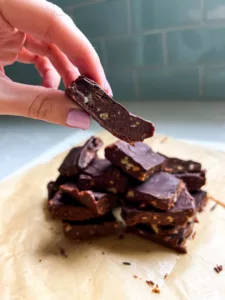
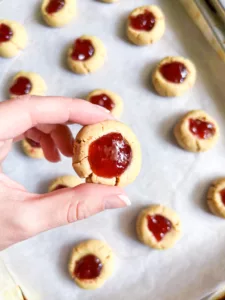
This took me a while to make but these came out really good. Not as nice as your photos but the flavor was definitely delicious.
Thank you so much Merry, I’m so glad you liked them 🙂